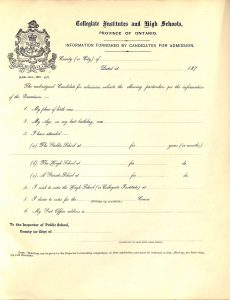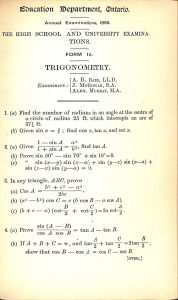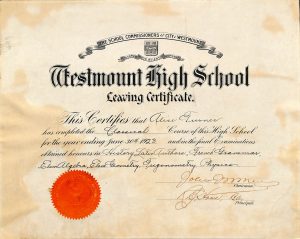The end of the school year has finally arrived! After all that you’ve learned this year, could you pass these provincial exit exams from our Ontario Historical Education Collections?
The OHEC houses a collection of provincial exams administered between 1873 and 1967. During this time, students were evaluated through a combination of high school entrance and exit exams, departmental (subject) exams, and normal school (teacher’s college) exams.

Students filled out this form prior to beginning their high school entrance exams. Taken from the Entrance Examination Papers, December 1874.
The Consolidated Act of 1874 published through the Department of Public Instruction for Ontario required that admission to a high school or collegiate institute was dependent on passing an entrance exam. To pass, students had to achieve a minimum score of 50%, which was awarded based on the completeness and accuracy of one’s answers. Entrance exams were held over two full days, and were evaluated by a board consisting of a county, city, or town inspector, a chairman from the public high school administering the exam, and the school’s headmaster. Students were tested in arithmetic, grammar, geography, spelling, dictation, and composition.

Questions from the Fourth Form Trigonometry departmental exam. Students would have opted to sit this exam for their Senior Leaving Certificate.
Each year, the Ministry of Education published a document containing the courses of study and examination requirements for all Ontario students. By 1896, these documents indicate that students preparing to exit high school had begun sitting for matriculation exams. While their scores were used to grant admission into university or normal schools, successful participants were also awarded with a Leaving Certificate that signified their completion of studies at the primary, junior, or senior level. To earn a Primary Leaving Certificate, students were required to pass all of their first and second form exams, which included sections in reading, English literature, composition and grammar, history, algebra, geometry, Latin, Greek, French, German, physics, bookkeeping, and stenography (shorthand writing).
Students seeking a Junior Leaving Certificate – a standard graduation certificate indicating four years of study, which was required for admission to universities and normal schools – were required to pass an additional department (subject) exam from any third form course; for a Senior Leaving Certificate (required for some university programs), students took an additional fourth form exam of their choosing. In addition to needing 50% overall to pass their exams, students had to score at least 33% on each individual exam to earn their certificates.

Similar to this certificate earned by a Montreal high school graduate, Ontario Leaving Certificates listed the departments from which the graduate completed successful final exams.
These standards remained throughout the 1920s. In 1931, the Ministry of Education began administering Graduation Diplomas to students who passed a minimum of 12 subject exams. These exams had to include British History, Physiology, English, Canadian History, and at least one math, biology, or language exam. Exams from the 1930s and 1940s were heavily based off of classroom textbooks approved by the government. However, by 1943, it was up to the individual principals to determine which courses their school should offer, and principals and teachers provided the final recommendation as to whether their students were eligible to graduate.
After 1949, entrance exams were eliminated across the province. Students continued to take departmental exit exams throughout the 1950s and 1960s. Junior and senior matriculation exams were held in June, while those in Grade 13 sat for their exams in August. Until the 1960s, these exam marks were the only measure of student achievement submitted to universities for consideration; universities determined acceptance based on one’s final exam marks rather than their year-round grades. As such, the number of departmental exams began to lessen, and the 1967-1968 school year was the last to require provincial exit exams.
To see a selection of Ontario provincial exams from the 1870s to 1960s, stop by the OHEC display case on the ground floor of the OISE Library. You can also browse our full collection of entrance, exit, and normal school exams by making a viewing appointment at the OHEC.
